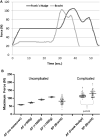Comparing forces on the fetal neck in breech delivery in lithotomy versus all-fours position: a simulation model
- PMID: 35857095
- PMCID: PMC10191913
- DOI: 10.1007/s00404-022-06671-5
Comparing forces on the fetal neck in breech delivery in lithotomy versus all-fours position: a simulation model
Abstract
Purpose: To measure forces applied to the fetal neck, in a simulation model for breech delivery, in both lithotomy versus all-fours position.
Methods: We used a Laerdal SimMom simulator and a Birthing Baby together with PROMPT Flex Software. The descent of the fetus was accomplished using the Automatic Delivery Module 2. The baby was always in breech position; the SimMom in either all-fours or lithotomy positions. Sensors were located inside the fetal neck region to simulate forces applied to the plexus.
Results: The lowest force on the fetal neck region was recorded for the delivery in all-fours position without further maneuvers (mean force 58.70 Newton, standard deviation 2.54 N). As weight was added to the baby, the force increased (i.e. + 500 g, mean force 71.8 N, SD 3.08 N, p < 0.001). Delivery in lithotomy position resulted in a mean force of 81.56 N (SD 19.55 N). The force significantly increased in case of delivery of the head without assistance from contractions (mean force 127.93 N, SD 23.10 N). In all-fours position, the delivery of the fetal head from pelvic floor level without contractions (Frank's Nudge maneuver) resulted in a mean force of 118.45 N (SD 15.48 N, p = 0.02). Maneuvers for shoulder dystocia (the inverted type that can occur during breech delivery) led to significantly higher mean forces independent from birthing positions.
Conclusion: Breech delivery in all-fours position was associated with the lowest force acting on the fetal neck in our simulation model.
Keywords: All-fours position; Brachial plexus; Breech delivery; Lithotomy position; Simulator; Spontaneous vaginal breech delivery.
© 2022. The Author(s).
Conflict of interest statement
All authors insure there is no potential conflict of interest.
Figures




Similar articles
-
Breech delivery in the all fours position: a prospective observational comparative study with classic assistance.J Perinat Med. 2015 Nov;43(6):707-13. doi: 10.1515/jpm-2014-0048. J Perinat Med. 2015. PMID: 25204214
-
Training for breech deliveries with the mother in an upright position: An innovative adaptation of a simulation model.Eur J Obstet Gynecol Reprod Biol. 2023 Jan;280:108-111. doi: 10.1016/j.ejogrb.2022.11.015. Epub 2022 Nov 21. Eur J Obstet Gynecol Reprod Biol. 2023. PMID: 36446258
-
Studying the Effects of Shoulder Dystocia and Neonate-Focused Delivery Maneuvers on Brachial Plexus Strain: A Computational Study.J Biomech Eng. 2024 Jan 1;146(2):021009. doi: 10.1115/1.4064313. J Biomech Eng. 2024. PMID: 38116838 Free PMC article.
-
[Shoulder dystocia: Guidelines for clinical practice--Short text].J Gynecol Obstet Biol Reprod (Paris). 2015 Dec;44(10):1303-10. doi: 10.1016/j.jgyn.2015.09.053. Epub 2015 Nov 2. J Gynecol Obstet Biol Reprod (Paris). 2015. PMID: 26541561 Review. French.
-
Shoulder dystocia: guidelines for clinical practice from the French College of Gynecologists and Obstetricians (CNGOF).Eur J Obstet Gynecol Reprod Biol. 2016 Aug;203:156-61. doi: 10.1016/j.ejogrb.2016.05.047. Epub 2016 May 30. Eur J Obstet Gynecol Reprod Biol. 2016. PMID: 27318182 Review.
Cited by
-
Vaginal breech delivery in all-fours position-Hands off instead of intervention: A prospective observational study.Acta Obstet Gynecol Scand. 2025 Jun;104(6):1153-1161. doi: 10.1111/aogs.15078. Epub 2025 Apr 1. Acta Obstet Gynecol Scand. 2025. PMID: 40165629 Free PMC article.
-
Experience of Labour and Childbirth in a Sample of Portuguese Women: A Cross-Sectional Study.Healthcare (Basel). 2024 Oct 24;12(21):2125. doi: 10.3390/healthcare12212125. Healthcare (Basel). 2024. PMID: 39517338 Free PMC article.
References
Publication types
MeSH terms
LinkOut - more resources
Full Text Sources
Research Materials

